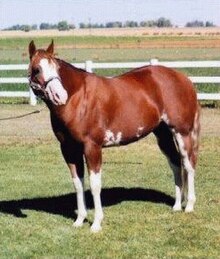

Sabino describes a distinct pattern of white spotting in horses. In general, Sabino patterning is visually recognized by roaning or irregular edges of white markings, belly spots, white extending past the eyes or onto the chin, white above the knees or hocks, and "splash" or "lacy" marks anywhere on the body. Some sabinos have patches of roan patterning on part of the body, especially the barrel and flanks. Some sabinos may have a dark leg or two, but many have four white legs. Sabino patterns may range from slightly bold face or leg white markings—as little as white on the chin or lower lip—to horses that are fully white.
The known causes of the sabino patterns are the SB-1 allele and several other dominant white (W) alleles on the KIT gene. The genetics behind some types of sabino, such as that found in Clydesdales, have not yet been identified. Some genes, such as Sabino-1, are incomplete dominants, producing irregular spotting when heterozygous, but when homozygous, can produce a horse that is almost completely white. Some forms of sabino are thought to be a reason for solid-colored horses with bold white markings on the face and high white leg markings.
Prior to the development and widespread use of DNA testing to determine equine coat color, the term broadly encompassed pinto patterns that did not clearly appear to be tobiano or frame overo. Some breed registries still use the term to describe spotting phenotypes that include roaning or irregular spotting, regardless of the precise genetics involved.